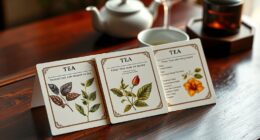Hello! I have some fantastic news to share – green tea is an absolute dynamo for your health! Loaded with antioxidants and offering numerous advantages, this simple drink can work miracles for both your physical and mental well-being.
From weight loss and boosting your metabolism to improving heart health and enhancing brain function, green tea has got it all. So, sit back, relax, and let me tell you about the 10 proven green tea benefits that will have you feeling your best in no time.
Key Takeaways
- Green tea can aid in weight loss and boost metabolism by increasing calorie burning and fat oxidation.
- Green tea is a powerful antioxidant, protecting against oxidative stress and inflammation.
- Regular consumption of green tea supports heart health by reducing inflammation, improving blood flow, and lowering cholesterol levels.
- Incorporating green tea into daily routine can enhance brain function and promote long-term brain health.
Weight Loss and Metabolism Boost
I can boost my metabolism and lose weight with a healthy diet and regular exercise. When it comes to weight loss tips, incorporating natural metabolism boosters can be highly effective.
One such natural metabolism booster is green tea. Green tea contains catechins, which are antioxidants that have been shown to increase metabolism and fat burning. Studies have found that green tea can increase calorie burning by up to 4-5% and fat oxidation by up to 17%.
Additionally, green tea can also help suppress appetite and reduce cravings, leading to decreased calorie intake. To maximize the benefits, it’s recommended to drink 2-3 cups of green tea per day.
However, it’s important to note that green tea should be used as a supplement to a healthy diet and exercise routine, rather than a standalone solution.
Antioxidant Powerhouse
Green tea is a quantifiable antioxidant powerhouse, providing numerous health benefits. Its antioxidant properties are well-documented and have been shown to help protect our bodies against oxidative stress and the damage caused by free radicals.
These antioxidants, such as catechins, have been found to have anti-inflammatory effects, which can be beneficial for reducing inflammation in the body. Studies have shown that green tea consumption may help alleviate symptoms of inflammatory conditions like arthritis and inflammatory bowel disease.
Additionally, green tea has been found to potentially reduce the risk of chronic diseases, including heart disease and certain types of cancer. Incorporating green tea into your daily routine can be a simple and delicious way to support your overall health and well-being.
Heart Health Support
Drinking green tea regularly can be an effective way to support heart health and reduce the risk of cardiovascular diseases. Numerous studies have shown the potential benefits of green tea in heart disease prevention and cardiovascular health improvement.
Green tea contains powerful antioxidants called catechins, which have been found to have a positive impact on heart health. These antioxidants help reduce inflammation, improve blood flow, and lower cholesterol levels, all of which are crucial for maintaining a healthy heart.
Additionally, green tea has been associated with lower blood pressure levels, which is another important factor for heart health. By incorporating green tea into your daily routine, you can take a proactive step towards protecting your heart and promoting overall cardiovascular well-being.
Brain Function Enhancement
Improving cognitive abilities through various techniques and practices is essential for enhancing brain function.
When it comes to brain health and cognitive function, there are several strategies that can be implemented to promote optimal mental performance. Regular physical exercise, a balanced diet, and quality sleep are all crucial for maintaining brain health.
Engaging in mentally stimulating activities such as puzzles, reading, and learning new skills can also help to improve cognitive function. Additionally, staying socially connected and managing stress levels are important factors in supporting brain health.
It’s important to prioritize self-care and engage in activities that promote mental well-being. By incorporating these practices into our daily lives, we can enhance our cognitive abilities and support long-term brain health.
Cancer Prevention
I can take steps to reduce my risk of cancer by maintaining a healthy lifestyle and avoiding known carcinogens.
Cancer prevention is crucial, and there are several strategies we can implement.
Firstly, maintaining a healthy weight is essential. Obesity has been linked to an increased risk of various types of cancer, including breast, colon, and pancreatic. By incorporating regular exercise and a balanced diet into our lives, we can achieve and maintain a healthy weight.
Additionally, certain foods have been associated with cancer prevention, such as fruits, vegetables, whole grains, and lean proteins. These foods are rich in antioxidants and other compounds that help protect against cancer.
Furthermore, it’s important to avoid known carcinogens, such as tobacco smoke, excessive alcohol consumption, and exposure to harmful chemicals.
Diabetes Management
During my recent visit to the doctor, I learned that managing diabetes requires regular monitoring of blood sugar levels and making healthy lifestyle choices. It’s crucial to maintain blood sugar control to prevent complications and promote overall well-being. Additionally, improving insulin sensitivity can also play a significant role in managing diabetes.
Here are four key strategies for effective diabetes management:
-
Regular physical activity: Engaging in exercise helps lower blood sugar levels, improves insulin sensitivity, and promotes weight loss.
-
Balanced diet: Consuming a diet rich in whole grains, fruits, vegetables, lean proteins, and healthy fats can help regulate blood sugar levels and enhance insulin sensitivity.
-
Medication adherence: Taking prescribed medications as directed by healthcare professionals is essential for controlling blood sugar levels and managing diabetes effectively.
-
Stress management: Implementing stress-reducing techniques, such as meditation or deep breathing exercises, can help maintain stable blood sugar levels and improve insulin sensitivity.
Digestive Health Improvement
Improving digestive health is essential for overall well-being. There are several ways to achieve this, and one effective method is through the consumption of green tea.
Green tea has been found to reduce bloating naturally, soothe digestive discomfort, and boost gut health.
Incorporating green tea into your daily routine can be a simple and enjoyable way to support your digestive system and promote better digestion.
Reduces Bloating Naturally
Drinking green tea helps relieve bloating, naturally reducing discomfort and promoting a healthier digestive system. Here are four reasons why green tea is beneficial for reducing bloating and improving digestion:
-
Reduces water retention: Green tea has diuretic properties that can help flush out excess water from the body, reducing bloating caused by water retention.
-
Aids digestion: The catechins found in green tea can help stimulate the production of digestive enzymes, improving digestion and reducing bloating caused by indigestion.
-
Calms the stomach: Green tea contains compounds that can soothe the stomach and alleviate gastrointestinal discomfort, making it an excellent natural remedy for bloating.
-
Anti-inflammatory effects: Green tea is rich in antioxidants, which have anti-inflammatory properties that can help reduce inflammation in the gastrointestinal tract, relieving bloating and discomfort.
Soothes Digestive Discomfort
I find that incorporating green tea into my routine with its soothing properties can help alleviate digestive discomfort and promote a healthier digestive system.
Green tea has been used for centuries as a natural remedy for various health issues, including digestive problems. It contains compounds called catechins, which have been found to have anti-inflammatory and antioxidant effects. These properties can help reduce inflammation in the digestive tract and soothe any discomfort or bloating.
Additionally, green tea contains caffeine and theanine, which can stimulate the production of gastric juices and improve digestion.
It’s important to note that while green tea can be beneficial for digestive health, it should be consumed in moderation and not as a substitute for medical advice or treatment. As with any natural remedy, it’s always best to consult with a healthcare professional before making any significant changes to your routine.
Boosts Gut Health
Since incorporating green tea into my daily routine, I’ve noticed that it boosts gut health and improves digestion. Here are four ways green tea can benefit your gut microbiome and digestive system:
-
Rich in antioxidants: Green tea is packed with polyphenols, which are powerful antioxidants that help reduce inflammation in the gut and support a healthy balance of bacteria in the microbiome.
-
Supports healthy digestion: Green tea contains catechins, which have been shown to promote the growth of beneficial bacteria in the gut and improve digestion.
-
Reduces bloating and gas: The polyphenols in green tea can help reduce bloating and gas by improving digestion and reducing inflammation in the gut.
-
Aids in weight management: Green tea has been found to boost metabolism and increase fat oxidation, which can help with weight management and overall gut health.
Incorporating green tea into your daily routine can be a simple and delicious way to support your gut microbiome and improve digestion.
Skin Health and Anti-Aging Effects
The article discusses the importance of maintaining a consistent skincare routine to improve skin health and combat signs of aging. Taking care of our skin is essential for overall well-being and confidence. A proper skincare routine can help prevent skin issues, promote skin rejuvenation, and reduce the appearance of wrinkles.
To achieve optimal results, it is crucial to understand the specific needs of our skin and choose products that address those concerns. Cleansing, moisturizing, and protecting the skin from sun damage are the foundation of any skincare routine. Additionally, incorporating targeted treatments such as serums or masks can further enhance the results.
To illustrate the benefits of a consistent skincare routine, let’s take a look at the following table:
| Skin Concern | Recommended Product |
|---|---|
| Dryness | Hyaluronic Acid Serum |
| Wrinkles | Retinol Cream |
| Hyperpigmentation | Vitamin C Serum |
| Acne | Salicylic Acid Cleanser |
| Sun Protection | Broad Spectrum SPF |
Immune System Boost
While there are many ways to boost the immune system, incorporating immune-boosting foods into our diet can be an effective strategy. Here are four foods that can help strengthen our immune system and support overall health:
-
Citrus fruits: Rich in vitamin C, citrus fruits like oranges, lemons, and grapefruits can enhance the production of white blood cells, which are vital for fighting off infections.
-
Yogurt: Packed with probiotics, yogurt helps promote a healthy gut, which is essential for a strong immune system. Look for yogurt brands that contain live and active cultures.
-
Leafy greens: Spinach, kale, and other leafy greens are loaded with antioxidants and essential nutrients like vitamin C and E. These nutrients can help combat free radicals and support a healthy immune system.
-
Garlic: Known for its immune-boosting properties, garlic contains sulfur compounds that stimulate the immune system and help fight off infections.
Incorporating these foods into your diet can’t only boost your immune system but also aid in weight loss, as they’re low in calories and high in nutrients. So, why not nourish your body and support your immune system at the same time?
Stress Reduction and Relaxation
Stress reduction and relaxation are essential for maintaining optimal mental and physical well-being.
Green tea has been found to have anxiety relief properties, helping to calm the body and promote a sense of calm and relaxation.
It’s believed that the amino acid L-theanine found in green tea is responsible for its calming effects, making it a great choice for those looking to reduce stress and improve overall mental well-being.
Anxiety Relief Properties
I’ve found that drinking green tea brings a sense of calm and tranquility, which helps alleviate anxiety. It’s a natural remedy that has been used for centuries to promote relaxation and reduce stress.
Here are four proven benefits of green tea for anxiety relief:
-
L-theanine: Green tea contains an amino acid called L-theanine, which has been found to promote relaxation and reduce anxiety. It works by increasing the production of alpha waves in the brain, which are associated with a state of relaxation.
-
Antioxidants: Green tea is rich in antioxidants, such as catechins and flavonoids, which have been shown to have a calming effect on the body and mind. These antioxidants help reduce oxidative stress and inflammation, both of which can contribute to anxiety.
-
Caffeine content: While green tea does contain caffeine, the amount is lower compared to coffee. This allows you to experience the calming effects of L-theanine without the jittery feeling often associated with high caffeine intake.
-
Ritual and mindfulness: The act of preparing and drinking green tea can be a mindful practice that promotes relaxation and stress management. Taking a few moments to focus on the present moment and savor the aroma and taste of the tea can help reduce anxiety and promote a sense of calm.
Incorporating green tea into your daily routine can be a simple and effective way to naturally manage stress and anxiety. Remember to consult with a healthcare professional if you have any specific concerns or questions.
Calming Effects on Body
Drinking a cup of green tea can have a calming effect on the body, helping to reduce stress and promote relaxation. Green tea contains an amino acid called L-theanine, which has been shown to increase alpha brain wave activity, inducing a state of relaxation without causing drowsiness. This can be particularly beneficial for individuals who are looking for natural ways to manage stress.
Studies have also suggested that green tea may improve sleep quality. The combination of L-theanine and other compounds found in green tea can help regulate sleep patterns and promote a more restful sleep.
Promotes Mental Well-Being
Taking time to practice mindfulness and engage in self-care activities, such as yoga or journaling, can greatly contribute to promoting mental well-being. These activities help us cultivate mental clarity and emotional balance, allowing us to navigate life’s challenges with resilience and grace.
Here are four ways in which mindfulness and self-care practices enhance our mental well-being:
-
Reduces stress: Mindfulness helps us become aware of our thoughts and emotions, allowing us to respond to stressors in a more calm and composed manner.
-
Improves focus and concentration: By training our minds to stay present, mindfulness enhances our ability to concentrate and pay attention to the task at hand.
-
Enhances self-awareness: Engaging in self-care activities like journaling helps us gain insights into our thoughts and feelings, leading to a deeper understanding of ourselves and our needs.
-
Boosts resilience: Practicing mindfulness and self-care equips us with the tools to cope with adversity, promoting emotional balance and overall mental well-being.
Frequently Asked Questions
How Much Green Tea Should I Drink Daily for Weight Loss and Boosting Metabolism?
To maximize weight loss and boost metabolism, I drink 2-3 cups of green tea daily. It’s been shown to aid in weight management and improve exercise performance. Plus, it’s great for gut health!
Can Green Tea Help Prevent Heart Disease?
Drinking green tea regularly can help prevent heart disease. Studies have shown that green tea can lower cholesterol levels and improve cardiovascular health. It’s a simple and enjoyable way to take care of your heart.
Does Green Tea Improve Cognitive Function and Memory?
Yes, green tea can improve cognitive function and memory. It has been shown to enhance brain function, increase focus, and improve concentration. Drinking green tea regularly can be beneficial for overall brain health.
Can Green Tea Lower the Risk of Certain Types of Cancer?
Yes, green tea can lower the risk of certain types of cancer. Studies have shown that the antioxidants in green tea can help protect against skin cancer and reduce inflammation, which can contribute to the development of cancer.
Is Green Tea Beneficial for Managing Diabetes and Controlling Blood Sugar Levels?
Green tea can be helpful in managing diabetes and controlling blood sugar levels. It has been shown to improve insulin sensitivity and reduce the risk of developing type 2 diabetes.
Conclusion
In conclusion, green tea is like a magical elixir that offers numerous health benefits. It can help you shed those extra pounds, protect your heart, enhance brain function, and even prevent cancer.
With its antioxidant power, green tea supports your immune system and improves digestion. It also promotes radiant skin and slows down the aging process.
So, grab a cup of green tea and let its soothing properties calm your mind and body, like a gentle breeze on a sunny day.










